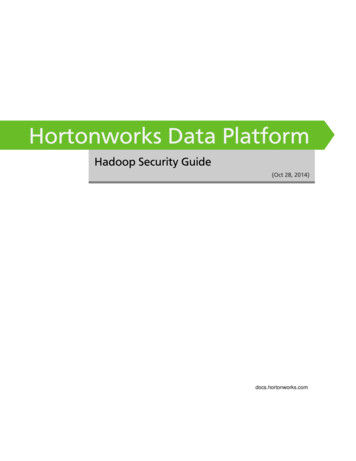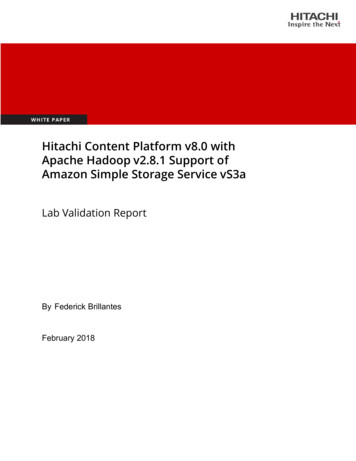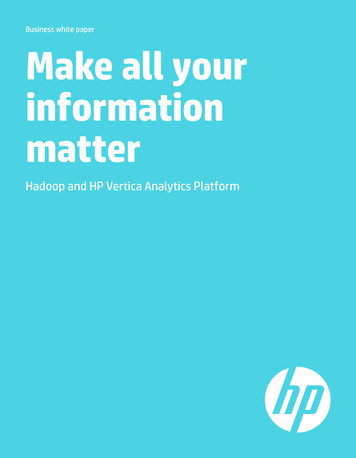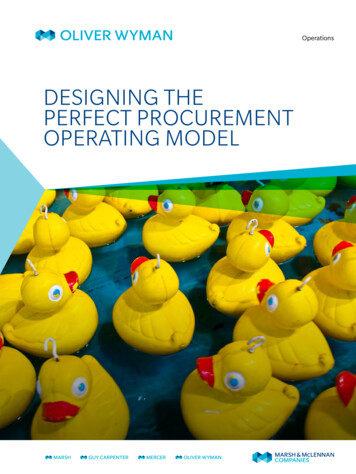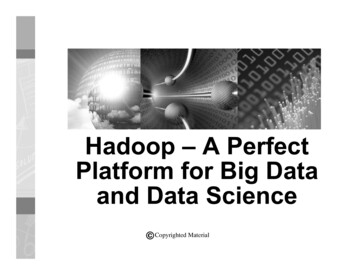
Transcription
Hadoop – A PerfectPlatform for Big Dataand Data ScienceCopyrighted Material
Agenda 2Data ExplosionData EconomyBig Data AnalyticsData ScienceHistorical Data Processing TechnologiesModern Data Processing TechnologiesHadoop ArchitectureKey Principles HadoopHadoop Ecosystem
Presentation Goal To give you a high level of view of BigData, Big Data Analytics and DataScience Illustrate how how Hadoop has become afounding technology for Big Data andData Science3
Data Explosion
“Big” Data in the News5
Data Creation Visually Illustrateshow much data isgenerated perminute.Source s.com/2012/06/dataneversleeps 4fd61ee2eda5a.jpg6
InfrastructureApplicationsUsersWhy so much data is beingGenerated today?71975Today2000 “online” users End Point2000 “online” users Start PointStatic User PopulationDynamic user populationBusiness Process AutomationBusiness Process AutomationHighly structured data recordsStructured, semi-structured andunstructured dataData networking in its infancyUniversal high-speed data networksCentralized computing(Mainframes and minicomputers)Distributed computing (Networkservers and virtual machines)
Data in an Enterprise Existing OLTP Databases– Organizations have several OLTP databases for the variousproducts and services they offer User Generated Data– Many social networking, blogging sites allow for users togenerate their own data Blogs, tweets, links Videos, audios Logs– Enterprise and Internet scale applications may have severalservers that generate log files Ex. Access log files System generated data8– Many services inside an enterprise generate syslogs that mayhave to be processed
Data in Personal Computing Let’s compare my PC from 19849My PC in1984My PC todayCPU ard DiskCapacity1MB1TBFactor300015,00030,0001,000,000
Data Volumes are Growing10
Data Economy
The Revolution in the Marketplace –The Shift195519601965HardwareWas King1219701975198019851990SoftwareBecomes King1995200020052010Data is theNew King
What are Data DrivenOrganizations?A data driven organizationthat acquires data,that processes data,and leverages data in a timely fashionto create efficiencies,iterate on and develop new products andnavigate the competitive landscape13
Data Driven Organizations Use DataEffectivelyData DrivenOrganizations14Organizations that use Data toaugment their Business
Big Data Business is Big BusinessDataAsASer-vicePAASDataGenerators AggregatorsDataAggregators EnablersBig Data BI DataAnalytics sw Tool VendorsBig DataCloud PlatformSoftwareIAASBig Datapublic CloudPlatformProviders(hw sw)Big DataHardwareManufactures
Information Science Is AffectingEvery www.youtube.com/watch?v 1-C0Vtc-sHwhttp://www.youtube.com/watch?v sm/Visualizationhttp://www.youtube.com/watch?v ?v uuUa4FEGvzo
Wake up - This is a Data Economy! We are in the midst of Information Science in themaking. Not long ago data was expensive. There wasn’tmuch of it. Data was the bottleneck for much ofhuman endeavor. No limit to how much valuable data we can collect! We are no longer data-limited, but insight limited.The people who know how to work with data are inshort supply.17
Big Data Analytics
What is Data?da-tanoun pl but singular or pl in constr, often attributive \ˈdā-təә, ˈda- also ˈdä-\– Factual information (as measurements orstatistics) used as a basis for reasoning,discussion, or calculation– Information output by a sensing device or organthat includes both useful and irrelevant orredundant information must be processed tobe meaningful– Information in numerical form that can bedigitally transmitted or processedsource: http://merriman-webster.com
Big Data Characteristics (Three Vs) Volume– Data volume on the rise– 44x increase from 2010 to 2020 Expected to go from 1.2zetabytes to 35.2zb Velocity– Speed at which the data needs to be transformed and processed isessential Variety– Greater variety/types of data structures to mine Structured Semi-structured20
Big Data Characteristics: DataStructures Data containing a defined data type, format,structure Example: Transaction data in OLTP and OLAPMore StructuredStructuredSemi-Structured Textual data with discernable pattern,enabling parsing Example: XML data files that are selfdescribing by xml schema “Quasi”StructuredTextual data with erratic data format, canbe formatted with effort tools and timeExample, web clickstream data that mayhave some inconsistencies in data valuesand formats Unstructured21 Data that has no inherent structure andis stored as different types of filesText documents, PDFs, images, video
Business Drivers for Analytics Many business Problems provide opportunities fororganizations to become more analytical & datadriven22DriverExamplesDesire to optimize businessoperationsSales, pricing, profitability,efficiencyExample: amazon.com, WalmartDesire to identify business riskCustomer churn, fraud, defaultExample: insurance, bankingPredict new business opportunitiesUpsell, cross-sell, best newcustomer prospectsExample: amazon.comComply with laws or regulatoryrequirementsAnti-Money Laundering, FairLending, Basel II (Operational RickManagement in Banks)Example: finance
Traditional Data Analytics vs. BigData AnalyticsTraditional Data AnalyticsClean DataClean Data/Messy Data/Noisy DataTBs of DataPBs of Data/Lots of Data/Big DataOften Know in advance the questions to askOften Don’t know all the questions I want to askDesign BI/DW around questions I ask?Architecture doesn’t lend for high computationTypically, answers are factual23Big Data AnalyticsNeed distributed storage and computationTypically, answers are probabilistic in natureStructuredStructured and UnstructuredDealing 1-2 domain data setsDealing with dozens of domain data sets
Traditional Data Analytics vs. BigData Analytics24Traditional DataAnalyticsBig Data pansionScale UpScale OutLoadingBatch, SlowBatch and Real-Time, rational, Historical, and PredictiveDataStructuredStructured and UnstructuredArchitecturePhysicalPhysical or VirtualAgilityReactiveProactive, Sense and RespondRiskHighLow
Quotable Quotes about Big Data“Data is the oil of the 21st century”- Gartner“Data is the crude oil of the 21st century. Youneed data scientists to refine it!”- Karthik
Data Science
What is Data Science?Using (multiple) data elements, inclever ways, to solve iterativedata problems that whencombined achieve businessgoals, that might otherwise beintractable27
Data Science – Another apted from DrewConway - http://www.drewconway.com/zia/?p 2378
Data mputingHadoopHDFSMap/Reduce
What Makes a Data Scientist?Data Scientist Curiosity Intuition Data gathering Standardization Statistics Modeling Visualization
How do I become a Data Scientist? Some things you can do:––––––––Learn about distributed computingLearn about matrix factorizationsLearn about statistical analysisLearn about optimizationLearn about machine learningLearn about information retrievalLearn about signal detection and estimationMaster algorithms and data structuresSource: -a-data-scientistEnroll at JHU EP Program.Take courses on Data Science and Big dataOnline or Face to Face!!!31
Going from Data ! WisdomWeb Site Interaction Normalized Data nsightsKnowledgeReportWisdom
Historical DataProcessingTechnologies
Supercomputers341977: CRAY-1A was used by NCAR(National Center for Atmospheric Research)to meet the needs of the atmospheric science community. Not in use any more.
Grid/Distributed Computing35
RDBMS Computing Big Idea– Use a single server with attached storage for storing and processingdata since they have to honor ACID properties Typically “scaled-up” (not scaling-out) by gettingbigger/more powerful hardware Scale-out achieved by Sharding, Denormalizing,Distr. Caching, which have their own cons Sharding requires you create and maintain schema on every server Denomalizing loses some of the benefits of relational model Distributed Cache suffers from “cold cache thrash”36
Historical/Traditional technologies don’t workbecause 37
All data cannot fit in a single machine and allprocessingcannot bedone ona single machineVeriSign ComputeCluster–KarthikShyamsunderImage: Matthew J. Stinson CC-BY-NC
Philosophy behind DistributedComputing “In pioneer days they used oxen for heavypulling, and when one ox couldn’t budge alog, they didn’t try to grow a larger ox. Weshouldn’t be trying for bigger computers,but for more systems of computers”- Grace Hopper, Computer Scientist and General in Navy
For Big Data Processing Scale isImportantWhatever system we choose, it has to scale for big dataand big data processing and it has to be economical!40
Big Data Computing inthe Modern World
Modern Computing Benefits/Trends Faster processing (CPU) and more memory– Thanks to Moore’s law Storage has become cheaper– Organizations are buying more storage devices to deal withhuge amounts of data Distributed systems design has matured– Hadoop movement, NoSQL movement Prevalence of Open-source software– A movement that started 20 years ago has yielded some of thebest software, even better than proprietary software More and more Commodity hardware– Systems of commodity servers rather than supercomputers Public Cloud computing– Companies like Amazon, Google are providing cloud options42
Modern Computing Challenges Disks I/O is slow– Servers typically use cost effectivemechanical disks which are slow Disks fail– Wear and tear, manufacturing issues,stuff happens Not enough networkbandwidth within datacenters to move all the bitsaround43– Once the data is read, transmittingdata within datacenter or across isslow
Solutions to Disk/IO Challenges Organizations use striping and mirroringtogether called RAID configuration– RAID stands for Redundant Array of Inexpensive disks– Use Striped (RAID0) and Mirrored (RAID1) configurationStriped44Mirrored
Hadoop
Hadoop History Timeline
What is Apache Hadoop? An open source project to manage “Big Data” Not just a single project, but a set of projectsthat work together Deals with the three V’s Transforms commodity hardware to– Coherent storage service that lets you store petabytes of data– Coherent processing service to process data efficiently47
Key Attributes of Hadoop Redundant and reliable– Hadoop replicates data automatically, so when machine goesdown there is no data loss Makes it easy to write distributed applications– Possible to write a program to run on one machine and thenscale it to thousands of machines without changing it Runs on commodity hardware– Don’t have to buy special hardware, expensive RAIDs, orredundant hardware; reliability is built into software48
Hadoop – The Big PictureUnified storageprovided bydistributed filesystem ibutedcomputingframeworkComputation e49Hardware containsbunch of disks andcores
Hadoop Technology StackYARNFrameworksHBaseNOSQL DBAncillary ProjectsAmbari, Avro, Flume, Oozie,Zookeeper etc.PigHiveScriptQueryMapReduce Distributed ProcessingYARN Distributed ProcessingHDFS Distributed StorageCommon Libraries/UtilitiesCore Hadoop ModulesAncillary Projects50
HDFS ArchitectureClientClients perform Metadata opcreate/deletefile/dir and re erations likead metadataMastered and WritClients Rea taNodeDaData odeDataNodesreplicatedata to each other5151Slave51SlaveSlave
YARN Architecture
ClientYARN Architecure veContainerNodeManagerContainer
ClientHDFS deContainer
Key PrinciplesBehind HadoopArchitecture
Key Principles behind Hadoop 56Break disk read barrierScale-Out rather than Scale-UPBring code to data rather than data to codeDeal with failuresAbstract complexity of distributed andconcurrent applications
Break Disk Read Barrier Storage capacity has grown exponentially butread speed has not kept up– 1990: Disk Store 1,400 MB Transfer speed of 4.5MB/s Read the entire drive in 5 minutes– 2010 Disk Store 1 TB Transfer speed of 100MB/s Read the entire drive in 2.5 hours What does this mean?– We can process data very quickly, but we cannot read fastenough, so the solution is to do parallel reads Hadoop - 100 drives working at the same timecan read 1TB of data in 2 minutes57Source: Tom White. Hadoop: The Definitive Guide. O'Reilly Media. 2012
Scale-Out Instead of Scale Up Harder and more expensive to scale-up– Add additional resources to an existing node (CPU, RAM)Moore’s Law couldn’t keep up with data growth– New units must be purchased if required resources can not beadded– Also known as scale vertically Scale-Out– Add more nodes/machines to an existing distributedapplication Software Layer is designed for node additions orremoval– Hadoop takes this approach - A set of nodes are boundedtogether as a single distributed system– Very easy to scale down as well58
Use Commodity Hardware “cheap” Commodity Server Hardware– Definition of “cheap” changes on a yearly basis– Today, it would cost about 5000 32GB RAM, 12 1 TB hard drive, quad core CPU No need for super computers withhigh-end storage, use commodityunreliable hardware– Not desktops!BUTNOT59Super-computers with high end storageRack of Commodity Servers
Googles’sOriginalChalkboardServer Rack60
Data to Code Not fit for Big Data Traditionally Data Processing Architecturesdivided systems into process and data nodes– Risks network bottleneckProcessingNodeProcessingNodeLoad DataSave ResultsLoad DataSave ResultsRisk Bottleneck61StorageNodeStorageNode
Code to Data Hadoop collocates processors and storage– Code is moved to data (size is tiny, usually in KBs)– Processors execute code and access underlying local storageProcessorStorageStorageHadoop NodeHadoop NodeProcessorProcessorStorageStorageHadoop Node62Hadoop NodeHadoop ClusterProcessor
Deal With Failures Given a large number machines, failures arecommon– Large warehouses see machine failures weekly or even daily– Example If you have hardware whose MTTF (Mean Time to Failure isonce in 3 years), if you have a 1000 machines, you will see amachine fail daily Hadoop is designed to cope with node failures– Data is replicated– Tasks are retried63
Abstract Complexity Abstracts complexities in developingdistributed and concurrent applications– Defines small number of components– Provides simple and well defined interfaces of interactionsbetween these components Frees developer from worrying about systemlevel challenges– race conditions, data starvation, processing pipelines, datapartitioning, code distribution, etc. Allows developers to focus on applicationdevelopment and business logic64
Hadoop Ecosystem
Hadoop Technology StackkafkaOpen MPIAmbari66
Categorizing Hadoop Tech Stack Data Integration– SQOOP, Flume, Chukwa, Kafka Data Serialization– Avro, Thrift Data Storage (NOSQL)– HBase, Cassandra Data Access/Analytics– Pig, Hive Data Access/Analytics 67– Giraph, Storm, Drill, Tez,, Spark. Management– Ambari Orchestration– Zookeeper, Oozie Data Intelligence– Mahout Security– Knox, Sentry Hadoop Dev Tools– HDT
Hadoop Distributions Offered first commercial distribution– Cloudera:Hadoop Redhat:Linux100% open source Hadoop with a twist– Proprietary admin/management consoleCloudera Hadoop Distribution is called CDH– CDH Cloudera Distribution for Hadoop 68 Offered second commercialdistribution100% open source Hadoop with atwist– Proprietary C based filesystem– Proprietary admin/managementconsoleMapR Hadoop Distribution iscalled Mseries– M3, M5, M7Third commercial distribution– Founded for ex-Yahoo Hadoop experts– Spin-off Yahoo100% open source Hadoop without any twist– 100% open source when it comes to Hadoop software– 100% open source admin/management tool called AmbariHotonworks Hadoop Distribution is called HDP– HDP Hortonworks Data Platform
Cloud Hadoop69
Summary Data being generated at a tremendous rate Emerging field of Big data analytics and datascience Businesses using both traditional data analyticsand data science Traditional data processing not suitable for “BigData” Processing Hadoop has become founding technology for Bigdata processing, Analytics, and Data Science!70
71
Hadoop – A PerfectPlatform for Big Dataand Data ScienceCopyrighted Material
Steps to Write aMapReduce Program
MapReduce Programming Model75
The Problem Given a directory called /in in hdfs thatcontains a bunch of great books as text files,List all unique words used in all books andtheir respective counts76
Solution Design77
Solution Design – Job Input Input location– /in folder contains a list of books in text format Input format––––78Lines of textSince text file, TextInputFormat classKey is LongWritableValue is Text
Solution Design – Mapper Map Input– Key is byte offset within the fileType is LongWritable– Value is line of text Type is Text Map Process– Ignore the key– Parse the value (line of text) For each word, print the word and a count of 1(one) Map Output– Key is word Type is Text– Value is count of 1 (one)79 Type is IntWritable
Solution Design – Reducer Reduce Input– Key is word Type is Text– Value is list of 1s (ones) Type is Iterable of IntWriable Reduce Process– Add up the 1s (ones) to a variable called count Reduce Output– Key is word Type is Text– Value is count Type is IntWritable80
Solution Design – Job Output Output location– /out will contain the output from reducer Output Format–––––81Text fileLines of text makes a recordKey is wordValue is countKey value separated by a tab
Steps to Write a MapReduceProgram1.2.3.4.5.6.82Implement the MapperImplement the ReducerConfigure the JobCompile the classesPackage the classesRun the Job
1. Implement the Mapper Create a class that extends Mapper class with 4parameters1. Map input key2. Map input value3. Map output key(Should be same as Reducer input key)4. Map output value(Should be same as Reducer input value)– Map Output key has to be WritableComparable– Rest of the parameters should be Writable at a minimum83
1. Implement the Mapper Override and Implement the map() method– Retrieve the passed input key and value– Write the logic necessary to do the processing– Use the passed Context to write the corresponding Mapperoutput key and value84
2. Write the Mapper Classpublic class WordCountMapper !!extends Mapper LongWritable, Text, Text, IntWritable { !!IntWritable one new IntWritable(1);!Text word new Text();!!@Override!protected void map(LongWritable key, Text value, Context context)!!! throws IOException, InterruptedException {!String line value.toString();!StringTokenizer tokenizer new StringTokenizer(line);!while (tokenizer.hasMoreTokens()) ord, one);!}!!}!}!85
2. Implement the Reducer Write a class that extends Reducer class with 4parameters1.2.3.4.Reduce input key (Should be same as Map input key)Reduce input value (Should be same as Map input value)Reduce output keyReduce output value– Input key classes should be WritableComparable86
2. Implement the Reducer Override and Implement the reduce() method– Retrieve the passed input key and list of values– Write the logic necessary to do the processing– Use the passed Context to write the corresponding Reduceroutput key and value87
2. Implement the Reducerpublic class WordCountReducer !!extends Reducer Text, IntWritable, Text, IntWritable {!!int i 0;!IntWritable count new IntWritable();!!@Override!protected void reduce(Text key, Iterable IntWritable values, !!Context context) throws IOException, InterruptedException {!!!i 0;!for (IntWritable val : values) {!i i 1;!}!count.set(i);!context.write (key, count);!!}!}!88
3. Configure the Job Configure Job in driver class and submit Instantiate a Job object– Several factory style get methods to get a Job instance Job.getInstance()– Used the default configuration object Job.getInstance (conf) Job.getInstance(conf, “jobname”)– Jobname is useful to track in the admin console– Possible to set the job name explicitly job.setName(jobName)89
3. Configure the Job - Input Specify the Input path– Could be file, directory or file pattern Directory or file patterns are converted to a list of files as input– In this case getting the path from command line args– TextInputFormat.addInputPath(job, new Path(args[0])); Can call addInputPath() several times for file, dir, or pattern Specify the Input data format– Input is specified in terms of InputFormat Responsible for creating splits and a record reader– In this case TextInputFormat Controls input types of key-value pairs, in this case LongWritableandText File is broken into lines, mapper will receive 1 line at a time– job.setInputFormatClass(TextInputFormat.class);90
3. Configure the Job - Process Set the Mapper and Reducer classes– job.setMapperClass(class);– job.setReducerClass(class); Specify which jar for the Job– job.setJarByClass(class);91
3. Configure the Job - Output Specify the Output path– Should be a directory– Output directory should not already exist– FileOutputFomat.setOutputPath(path) Specify the Output data format– Output is specified in terms of OutputFormat– For text files, it is TextOutputFormat– job.setOutputFormatClass(TextOutputFormat.class); Specify the Output key-value classes– job.setOutputKeyClass(keyClass);– job.setOutputValueClass(valueClass);92
3. Configure the Job - Outputpublic class WordCount {public static void main(String args[]) {Job wordCountJob null;wordCountJob Job.getInstance(new Configuration(), "WordCount");// Specify the Input pathFileInputFormat.addInputPath(wordCountJob, new Path(args[0]));// Set the Input Data rmat.class);// Set the Mapper and Reducer r.class);// Set the Jar filewordCountJob.setJarByClass(WordCount.class);// Set the Output w Path(args[1]));93
3. Configure the Job - Output// Set the Output Data Format.class);// Set the Output Key and Value // Submit the jobwordCountJob.waitForCompletion(true);}}94
4. Compile the Classes Compile Mapper, Reducer and Main job classes Include Hadoop classes in CLASSPATH– All hadoop jar files– Dependent jars in the lib folder Include App dependent classes in CLASSPATH– If mappers and reducers require other dependent libraries, you needto include them in the CLASSPATH too95
5. Package the Classes Hadoop requires all jobs packaged as single jar– Hadoop framework distributes jar file to nodes Specify in code which jar file to distribute– Specify jar of your job by calling job.setJarByClass job.setJarByClass(getClass());– Assuming the current class is part of the job of course– Hadoop will locate the jar file that contains the provided class Dependent jars should be packaged within big jar– Dependent jars are expected to be placed in lib/ folder inside jar file96
6. Run the Job Two ways to run the program1. Traditional java command You have to set HADOOP CLASSPATH java –classpath mapreduce-basics.jar: bdpuh.mapreducebasics.WordCount /in /out2. Use the more convenient yarn command Adds Hadoop’s libraries to CLASSPATH yarn jar t /in /out 97
The Output Files Output directory will have resultant files– SUCCESS Indicating job was successful, otherwise file will not be present– Reducer output files with format “part-r-nnnnn” nnnnn is an integer representing reducer number Number is zero based98
Steps to Write aMapReduce Program
“In pioneer days they used oxen for heavy pulling, and when one ox couldn’t budge a log, they didn’t try to grow a larger ox. We shouldn’t be trying for bigger computers, but for more systems of computer


